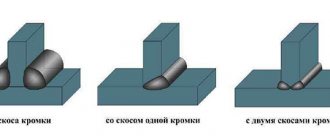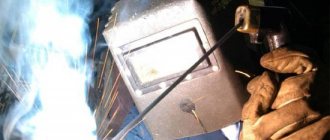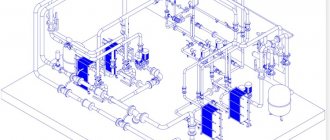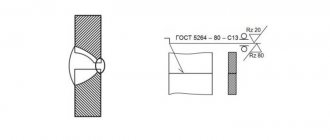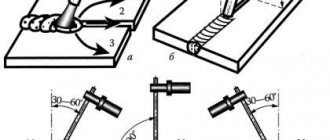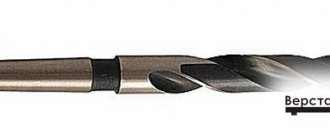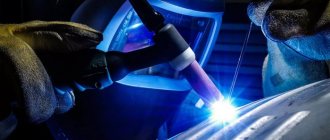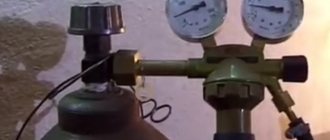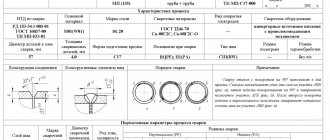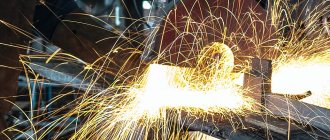GOST standards used in welding
Metal welding, carried out by local melting of the edges of the parts being joined, is the main technology used to make permanent connections.
The development and improvement of the welding process has led to the emergence of varieties of this technology, differing in the scope of application, the equipment and consumables used, as well as the nature of the welding process itself.
By virtue of tradition, all production procedures of any significance are standardized on a national scale. The standard is an integral part of the planned economy.
For this reason, there are a number of state standards (GOST) that define standards for performing various types of welding processes.
Manual arc welding process
Manual arc welding is most common in everyday life and small-scale production. This is a type of welding process in which piece replaceable electrodes are used, coated with a special composition, which, when burned, forms a protective gas environment.
The type of electrode coating used is determined by the material being welded and the nature of the welding current. The electrodes produced are divided into those that are designed to operate on alternating current welding, and those that use a direct current apparatus for welding.
The procedure for performing work using this technology is regulated by two GOSTs.
GOST 5264 - 80 establishes the rules for execution and graphic designation in drawings of the main types of connections of steel structural elements using manual welding. The main types of welded joints include:
- butt, during which the elements are connected with their ends aligned in the same plane;
- angular, characterized by the fact that the connected ends of the parts are located in planes perpendicular to each other;
- tee, which consists in connecting the end of one workpiece with the flat surface of another at a right angle;
- overlapping, connecting workpieces in parallel planes with one superimposed on the other.
The state standard establishes the procedure for preparing surfaces for making permanent welded joints, including the exact geometry of the cuts of the edges of the workpieces. Separate sections of the standard are devoted to welding workpieces of different thicknesses.
GOST 11534 - 75 refers to connections in which the workpieces form acute or obtuse angles with each other. Various methods of preliminary preparation for welding of product edges are described, indicating the exact geometric dimensions.
There are regulatory documents for electrodes as well. GOST 9467 - 75 defines the requirements for the composition of the coating of steel electrodes depending on the properties of the materials being welded, as well as the mechanical characteristics that the welds must have.
The most important of these characteristics are the indicators of the ductility of the welded joint and the magnitude of the destructive stresses that arise under certain types of load of this joint.
Under a layer of flux
Submerged arc welding technology is widely used in the assembly of large steel structures. Flux can be powdery or have a liquid consistency. This type of process includes gas shielded welding.
GOST 8713 - 79 determines the procedure for performing work with various options for using fluxes. This state standard describes the performance of work using mechanized and automatic welding.
GOST 1533 – 75 is dedicated to submerged arc welding of workpieces using automatic and semi-automatic welding machines. The types of welded joints with the arrangement of the edges of the connected elements in planes forming acute and obtuse angles among themselves are considered.
GOST 14771 - 76 describes the processes of creating welded joints in an environment of inert gases or their mixtures using consumable and non-consumable electrodes. The exact geometric dimensions of the bevels made at the joined ends of products made of steel and alloys based on iron and nickel are shown.
When connecting pipes
Due to the high responsibility of the work carried out during the construction of pipelines, a separate GOST 16037 - 80 is devoted to the implementation of welded joints on them.
This GOST applies to elements of steel pipelines, the permanent welded connection of which is made using various technologies. Manual, semi-automatic and fully automated electric arc processes can be used, as well as gas welding .
In the latter, the pipe material melts from the heat generated by the combustion of the gas mixture. To work safely with gases, it is important to follow the appropriate instructions.
For aluminum workpieces
Aluminum, being a low-melting metal, requires a special approach when choosing a technology for the production of welded joints.
When melting, this metal easily splashes, which prevents the creation of a high-quality seam. GOST 14806 – 80 defines the arc welding process of aluminum and its alloys in an inert gas environment.
There are state standards that regulate the procedure for carrying out work on such types of welding as spot, pulsed laser, contact.
GOST standards cover almost all materials used in welding processes and the equipment itself.
The symbols for welding connecting seams used in design technical documentation are also determined by GOST.
GOST for semi-automatic welding in carbon dioxide
Welding in a protective atmosphere is a progressive technology for creating permanent joints of workpieces made of non-ferrous and ferrous metals. They are used in a wide range of applications, from construction to aerospace. To guarantee the strength and durability of seams in critical structures , GOST 14771 76 “Seams of welded joints, gas-shielded welding” regulates the types of seams, methods of cutting edges, quality control methods and other points.
Types of welded joints and seams
Welding of ferrous metals and stainless steel, defined by GOST 14771 76, provides for the following main types of welded joints:
- butt;
- T-bars;
- overlap;
- corner.
Butt
Two sheet or pipe blanks are in the same plane, the seam fills a small gap between them . This is the most common type. It ensures minimal consumption of welding materials and labor intensity. The seam can be one-sided, welded only from the top, or double-sided, which is welded sequentially (or simultaneously) on both sides.
When welding workpieces of medium and large thickness (more than 4 mm), to ensure deep penetration, the edges of the workpieces are cut, chamfering them. The type of cutting depends on the one-sidedness of the seam and the thickness of the sheet
With a sheet thickness of 12 mm or more, it is recommended to use a double-sided seam and an x-shaped groove. This improves penetration and saves welding materials.
Tavrovoe
Connects two sheets (or strips) of the same or different thickness . Depending on it, a one-sided or two-sided seam is used, with or without cutting.
For better penetration of metal workpieces when making such a weld, the workpieces are placed at an angle of 45° to the vertical
Recommended position for welding T-joints and corner joints.
The T-joint should be welded on both sides. When the workpiece thickness is more than 4 mm, cutting is used. In industrial conditions, welding is carried out mechanized on special stands.
Angular
The connection is used in the assembly of various bodies and vessels. If possible, it is also recommended to weld the internal seam at an angle of 45°, just like the T-seam.
overlap
Used to increase the strength of the joint, in this case it is boiled on both sides. It is also used for the repair of pipelines and steel vessels, using a one-sided seam.
Classification according to other criteria
Welding seams GOST 14771-76 are also divided according to other parameters.
According to the degree of profile convexity, they are divided into categories such as:
- convex;
- ordinary;
- concave.
According to spatial position, they are distinguished:
- bottom: most convenient for forming a high-quality seam;
- horizontal, there is a risk of melt leakage;
- vertical: medium risk of leakage;
- ceiling: the most complex, special modes, techniques and materials are used.
Welding positions.
The lower position also achieves the highest welding speed and overall productivity. No highly qualified worker is required.
Definition and Features
Welding GOST 14771-76 is carried out using several types of process. Their decoding is as follows:
- IN - in inert gases with a non-consumable electrode. Arc welding is carried out without the use of a filler rod or wire. The electrical circuit is closed by an infusible tungsten-based electrode. Used for connections with minimal clearance; all suture material is formed from blank metal. When working, you should be guided by GOST for argon welding.
- INp - the same, but with filler materials. This method allows you to obtain the most durable seams. The filler rod is fed by the welder into the argon arc welding working area manually. The wire is fed by a semi-automatic welding machine at a constant speed. The filler material melts and becomes part of the weld material. The process is described by a separate GOST for semi-automatic welding. Filler wire, its composition, dimensions and mechanical properties are also described in GOST for semi-automatic welding in shielding gas.
- IP - in inert gases and their mixtures with Co2 and oxygen with a consumable electrode. In this case, the electrode closes the electrical circuit and at the same time serves as a source of filler material, melting and replenishing the weld pool.
- UP - in carbon dioxide with a consumable electrode. The technology is similar to IP, but carbon dioxide is used instead of expensive inert gases. The connection quality is lower and is used for mass execution of less critical connections.
